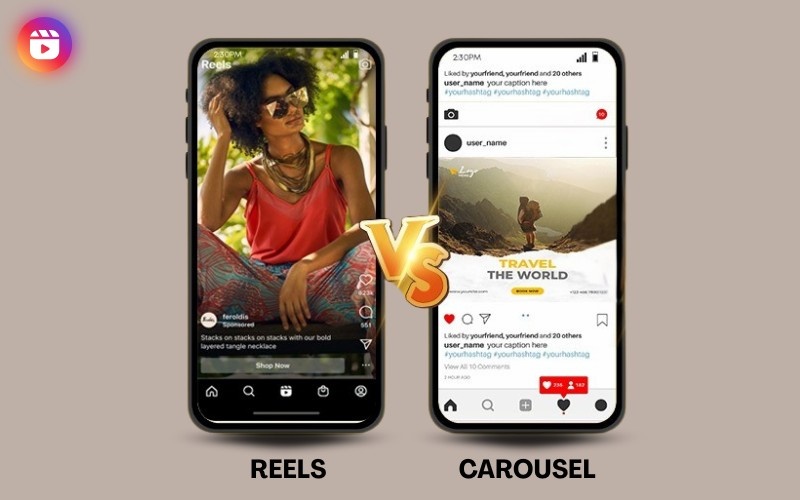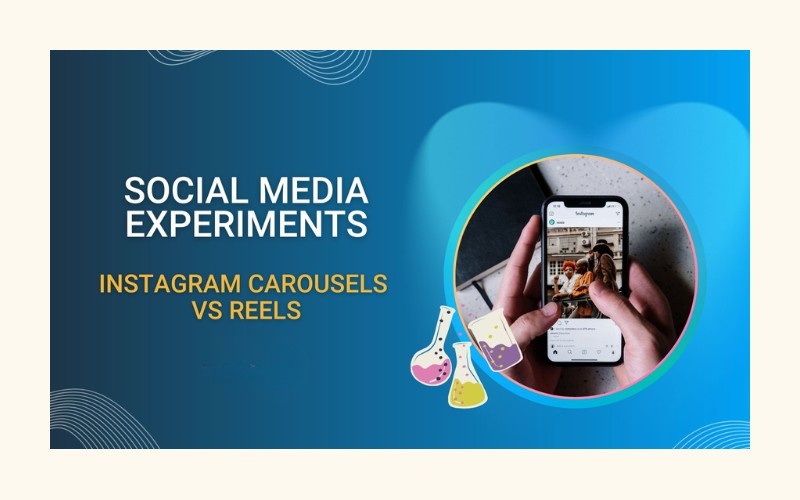In the era where social media marketing is important, each swipe, click, and tap counts. As digital platforms such as Instagram take over the digital relationship-building process, brands are consistently testing different content formats to increase engagement and, most importantly, conversions. The two most obvious content types are carousels and reels, each of which has its advantages. But when it comes to performance and output, especially in terms of turning viewers into customers or leads, which one is supreme?
Understanding the Power of Carousels
Carousels are multi-image or multi-video posts that the user swipes horizontally. It is a presentation type that suits storytelling, educational material, product explainer and tutorial, and more in-depth interactions. The reason why carousels are strong is that they are attention-grabbing in progression. The more you swipe, the more you show that you are interested; the more you slide, the more you are bringing the viewer into your narrative or pitch.
Such posts are particularly effective among brands and influencers who wish to demonstrate extensive material. As an example, the brand selling fitness supplements could use a carousel to demonstrate the results, describe how to use the products, provide their ingredients, testimonials, and conclude with a strong call to action. Due to this depth, carousels can be useful in the middle of the funnel and bottom of funnel marketing, where the audience is somewhat interested but still has to be persuaded further in order to make a conversion.
The saveability and shareability of the carousels are another strength of carousels. Value posts should be easier to save and share, which are both likely to be sent to the algorithms and explain some user intent. Carousels inspire mindful consumption and tend to match with content that audiences are interested in referring to in the future, and this helps improve engagement metrics, which ultimately promotes conversions.
Reels: Virality at High Speed
Reels, the short video section of Instagram, have become the center of attention due to the algorithm on the platform as well as the growth of the general snackability element of content. These videos comprise 15 to 90 seconds, and in general,,l they are often trend-adaptable, musician-based as well as visually heroic. Reels are a high-fidelity storm trooper- they are designed to entertain, surprise, or inform in short spurts, and the algorithm sends the reels that perform well to new audiences through the Explore page.
This structure is especially fit for brand awareness. If a reel has pleased the algorithm, a small business may transform itself into a company with thousands of followers in one night. The pace, expandability, and shareability of reels can be shocking. However, with the power of reach, there is also the power of responsibility, i.e., ensuring that visibility is converted into action.
Conversions will require a strategically designed reel. Just being a follower of the trends can make the audience in, but not the outcome. Using a clear call to action, product demonstrations, unboxings, as well as influencer endorsements are the most successful reels to convert. An example would be a fashion brand presenting several outfit concepts in one video, and an end-screen where people can go to their store or visit their bio link.
Algorithm vs. Intent
The gap between the performance of carousel and reels is also determined by their placement, interaction with users, and treatment by the Instagram algorithm. The accounts that do not follow yours are actively pushed to he reels, and you have an opportunity to expand your audience. Carousels, instead, are most popularly resorted to for the presentation to faithful fans, which is the best way of maintaining relations and leading them closer to the bottom of the funnel.
Therefore, when the desired is retention and conversion, carousel will email claims that the best way to reach people is via reels, and carousel will excel in such. The viewer who takes the time to scroll a carousel is already interested and has a greater chance of making a purchase or inquiry than the passive scroll viewer who saw a fancy reel and thought nothing of it afterward.
Which One Converts Better?
In case conversions are your barometer of success, carousels tend to be more profound, transparent, and interesting. Their experience is of a more layered kind, in which an individual can take the information and digest it at his/her rate, store the material, and think about it before acting. Reels are entertaining and expansive, but more times than not, they will need aggressive call-out actions or secondary content to finish affecting the conversion loop.
But the hybrid approach is best. Reels help to capture new audiences and create a buzz, whereas carousels are used to teach, inform, and sell to the audience. The two forms are mutually exclusive, or rather complement each other. The brands with a clear view as to how to combine the two are usually the ones with the most favorable outcomes throughout their customer journey.

When to Use Reels vs. Carousels
It is critical to know which type of content has better conversions, but it is more than the format; it is the strategic intent. In the process of creating a content strategy, it is necessary that the marketers outline every piece of the content to a particular goal. Here, Reels and Carousels can go hand-in-hand with one another, reaching a mutual benefit together.
As an example, there can be a brand that is releasing a new product. The perfect release may begin with a Reel generating curiosity, carousal the use of visuals with theatrics, trendy sound effects, with VIP excerpts to allure the product. After the interest is generated and the engagement starts to gain popularity, it is time to introduce Carousels that will carry out the necessary follow-up: provide the features, pricing, contrast, and testimonies. This tiered strategy helps to bring the customer through the stages of curiosity, then consideration, and finally conversion.
Reels are also very effective when it comes to seasonal promotion, flash sale, or when virality causes a direct action. Carousels, in their turn, have greater worth in evergreen marketing, i.e., how-to articles, educational posts, or case studies of users that do not go out of fashion.
Analytics and Conversion Tracking: What the Numbers Say
In terms of performance analysis, Instagram Insights provides various values within every type of content, and it also corresponds to the way it works. Reels have measurements regarding reach, plays, shares, and saves, whereas carousels have measurements regarding interactions such as swipes, saves, likes, and comments. However, once we reach the true conversion tracking, some brands may require be ability to go beyond in-app tracking- in the form of UTM parameters, web analytics, and conversion pixels.
Case studies also demonstrate that carousel posts that contain content of educational or value-based nature regularly have higher save rates, which is a good indication that the audience would view the post as valuable on later occasions, and that is usually a good indication of future conversions. At the same time, reels are more likely to promote top-of-funnel activities like profile visits and new followers. Being fed with specific carousel content, these new followers are more likely to be converted in the future.
Brands monitoring both stages of the journey notice that the Reel-to-Carousel route may become very effective: immediately obtain the attention with short-form video and retarget with carousel ads or static posts, educating and persuading.
Niche Examples: Real-World Success Stories
Tradehow, the style industry, such as Alo Yoga and Zara, makes use of reels to share outfit switches, celebrity appearances, and BTS videos. These tend to spread like wildfire, attracting a cascade of new converts. Their carousel posts, on the contrary, such as lookbooks, styling hints, or collections of a season, are more likely to contain comprehensive details, a high level of urgency, and lead to product pages, making sales grow.
Tech companies, such as Notion or Grammarly, use carousels to provide tutorials, productivity hacks, as well as a highlight of features. They can be shared in specialized communities and are regularly bookmarked, which is a clear indication of the direction of education toward the consumption of a product.
This combined approach is evidence that both formats have a different yet equally important place in conversion optimization.
Choosing the Right Format for the Right Goal
The point is that there is no general answer to the question of which format is better, Reels or Carousels, as these two are just two different contributions to the customer journey at different points. Reels are perfect to receive attention, gain new followers, and generate brand presence in the context of trends and the rapid environment. Carousels offer the opportunity to teach, convince, and convert through a well-organized story and stratified value instead. The brands able to work both forms to attract using Reels and convert using Carousels are winning the game on social media nowadays. Instead of picking either, the wittiest decision is to combine both into a content strategy that would show your brand voice, business objectives, and customer needs.
When you are ready to accomplish the conversion of content into conversions by using a balanced and evidence-based approach, Digiworq is your creative growth agency. We make content work, whether it is in reels, which halt the scroll, or carousels, which bring sales to life.
Why not craft a conversion engine content?- Get to www.digiworq.com today.














